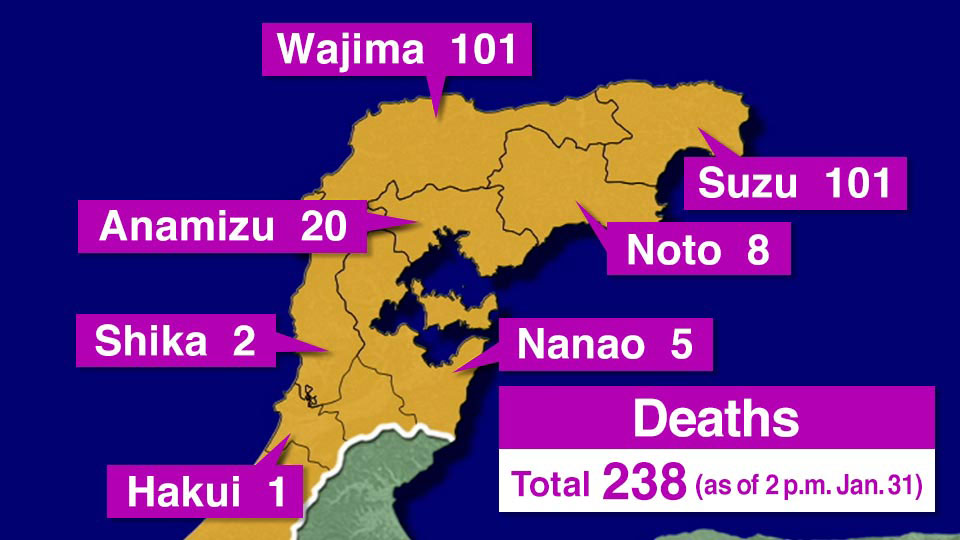Residents of the disaster area observe a moment of silence at 4:10 p.m. on Thursday — the exact moment the quake struck a month ago — to remember those who died.
In Ishikawa Prefecture, near the epicenter, the quake took 101 lives in Wajima City; 101 lives in Suzu City; 20 lives in Anamizu Town; eight lives in Noto Town; five lives in Nanao City; two lives in Shika Town and one life in Hakui City. A total of 1,179 people were injured. Nineteen people remain unaccounted for.

In Ishikawa Prefecture, 9,851 people remain in primary and intermediary evacuation facilities in the disaster area, while 4,792 evacuees are being housed in more distant secondary shelters, such as hotels.
The scale of the disaster can be seen through a variety of data.
More than 67,000 buildings damaged
In Ishikawa Prefecture, 47,915 buildings, including houses, were damaged. The figures for Niigata and Toyama prefectures were 13,654 and 6,058, respectively.
A massive fire in Wajima City's center destroyed more than 200 buildings in a 48,000 square-meter area.
The first 18 temporary housing units in Ishikawa Prefecture were completed on Wednesday in Wajima City. Evacuees will begin moving into them on Saturday.
Ishikawa Prefecture plans to begin building at least 3,000 more units by the end of March.
Power and water disruptions
The quake cut power to 39,900 households in Ishikawa. Power has now been restored to 94 percent of them, but about 2,500 remain off the grid.
Ishikawa Prefecture officials say water supplies were disrupted for 110,000 households. Currently 40,890 households still lack running water. Most of them are located in Wajima City, Suzu City, Anamizu Town, Noto Town, Nanao City and Shika Town.
Professor Nojima Nobuoto of Gifu University has compared the pace of water restoration one month after the Noto temblor with that of two previous quake disasters. He says the water supply was almost fully restored one month after the 2016 Kumamoto Earthquake, and over 80 percent was restored a month after the 2011 Great East Japan Earthquake and the 1995 Great Hanshin-Awaji Earthquake.
Health ministry officials say the pace of restoration in Ishikawa Prefecture has been slower because in addition to water pipes, water purification plants and water distribution ponds also suffered severe damaged.
Cost of destruction
Japan's Cabinet Office estimates the cost of the damage at 2.6 trillion yen, or about 17.6 billion dollars.
It's believed the damage in Ishikawa, Niigata and Toyama prefectures will total a maximum 8.8 billion dollars, 6 billion dollars and 3.4 billion dollars, respectively.
Damage to fishing industry
The fishing industry — a regional economic mainstay — was also severely damaged in the disaster area.
Sixty of the 69 fishing ports in Ishikawa suffered damage, including seabed elevation. At least 18 of the ports cannot unload fish.

Although the number of earthquakes is gradually decreasing in the Noto region and surrounding areas in Ishikawa Prefecture, seismic activity continues.
The Meteorological Agency says people should be prepared for the possibility of earthquakes with an intensity of lower 5 or stronger on the Japanese seismic scale of 0-7 for the next two to three weeks.
After major earthquakes struck the Sea of Japan coast in the past, significant temblors with a magnitude of over six took place even a month later.
As of Feb. 1 at 4 a.m., 1,566 earthquakes with an intensity of one or higher had been recorded.
Nuclear power plant damaged
The operator of Shika Town's nuclear power plant — whose two reactors have been offline since 2011 — says it may take months to complete quake repairs.
Hokuriku Electric Power Company notes the quake damaged transformers used to supply power to the Shika plant, as well as two of five power cables, but says there is no safety risk.

The quake also disrupted communication with 18 of 116 monitoring posts that measure radiation. They're installed within a 15 to 30 kilometer radius around the plant.
Seventeen of the posts are in Wajima City and Anamizu Town. Data from those areas suffered disruption but all monitoring posts were restored by January 31.
115 million dollars in donations
Ishikawa Prefecture says that as of Tuesday its fundraising campaign has collected cash donations amounting to over 16.9 billion yen, or about 115 million dollars.
It has decided to provide 50,000 yen or 340 dollars to all residents in Nanao City, Wajima City, Suzu City, Shika Town, Anamizu Town and Noto Town, saying they are still enduring harsh conditions such as a lack of running water. Nearly 125,000 people are eligible.
Ishikawa will also provide about 1,360 dollars to the families of prefectural residents who died in the disaster and to residents whose houses were completely destroyed.
Donations are also flowing in from overseas.
The Foreign Ministry says the US government has announced it will provide 100,000 dollars to an NGO that is aiding quake victims.
A funding drive by Taiwan's government raised more than 2.5 billion yen, or about 17 million dollars, in just two weeks.
The South Korean government has announced it will provide 3 million dollars in humanitarian aid for Japan's recovery efforts.
In addition, South Korea's North Jeolla Province and the city of Busan have each announced they will donate 100,000 dollars.
The Mongolian government has announced it will provide 100,000 dollars.
Related stories:
South Korea to provide $3 million for quake relief for Japan's Noto Peninsula
Taiwan holds ceremony to hand over public donations for Japan's quake-hit areas
Volunteers now flowing in
For the first few weeks after the quake, authorities had asked individual volunteers to refrain from entering the disaster area due to poor road conditions as well as a lack of water and accommodations.
On Saturday, however, Ishikawa Prefecture began accepting volunteers in three municipalities. Eighty people a day are now helping residents in Nanao City, Shika Town and Anamizu Town. More volunteers will be accepted from next Saturday. Governor Hase Hiroshi announced Wednesday that over 18,000 people have registered as volunteers.

